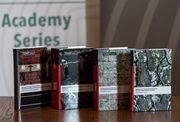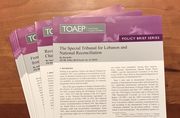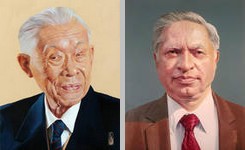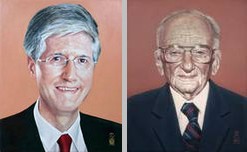Closing remarks by Gregory S. Gordon
New Delhi, 23 February 2019
Conference web page with materials | Film of Gordon's presentation of this text
I have heard the great international criminal law expert – and my dear friend – Professor Roger Clark say on more than one occasion that legal scholars roughly divide into two broad categories: “philosophers” and “plumbers”. Philosophers look at the more profound, more conceptual issues and offer more theoretical insights, often inter- or multi-disciplinary, on how to re-think or re-order the area concerned. Plumbers are less catholic in approach and more interested in the legal order’s “pipes”, if you will – their placement and how they fit together – the mechanics of the process, as it were – and they offer more practical solutions in terms of constructing or fixing the system. Roger, quite humbly and I think rather inaccurately, refers to himself as a plumber. And I see somewhat of an analogy between Roger and the incredible conferences put on by the Centre for International Law Research and Policy (‘CILRAP’). Let me explain.
Many probably look at Professor Clark’s crucial work in helping put together the Rome Statute or the Kampala Amendments and concur with his self-deprecating pipe-master self-assessment. But one can equally look more deeply at his brilliant insights on modes of liability or his explorations of the dimensions of the crime of aggression and realize that he is just as much of a philosopher as he is a plumber.
So how does this relate to CILRAP conferences? To answer this question, we need only look at some of the more recent ones, such as “The Philosophical Foundations of International Criminal Law” or “Power in International Criminal Justice: Towards a Sociology of International Justice”. These clearly smack of the more philosophical and, in general terms, we could easily classify them that way. But look a little more closely and you will see a range of practical issues that participants engaged with at these conferences – the definition of crimes, the efficacy of protocols, and the politics of prosecuting, among others. Upon closer inspection, then, one realizes that much “plumbing” underlay and informed the “philosophy” that was the backbone of those symposia and their subsequent books that followed as part of the project. I think that this is a great credit to CILRAP. For, in planning and putting on those conferences, CILRAP, and Morten Bergsmo in particular, with his policy papers and pre-conference notes to participants, meaningfully challenged participants to consider the practical dimensions of the more ethereal, academic discourse at the heart of those gatherings. And, so, at this type of CILRAP conference – and their attendant TOEAP publications – philosophizing has been well-married with plumbing!
Now, let us turn our attention to why we are all here today. One could certainly look at a title like “Quality Control in Criminal Investigation” and immediately think that this is a conference strictly about plumbing! In fact, Morten’s reference to the “Seven Bottlenecks” in his policy paper might be seen as the ultimate plumbing metaphor! And, to be sure, this is a conference that has offered tremendous practical insight into how we can help fix that phase of proceedings that spans from the opening of the criminal investigation until the start of the trial. But again, I think, Morten has asked us to think much more deeply and get out of our comfort zones.
And I quote here various snippets of his policy paper, quite revealing in this regard, where he refers to the more abstract notions of “fact-rich” cases, “a culture of quality control”, “a freedom to challenge the quality of work”, “micro-prioritization”, “confirmation bias”, “meta-evidence”, “nuanced narratives”, “subsumption-analysis capacity”, “multi-disciplinary evidence review” and “social anthropology”. And, thus, in that paper, he explicitly encouraged us “to develop new ideas for what can be done differently and how”. Honest problem-descriptions, we were reminded, are vital but not enough. To generate new ideas, minds from outside established criminal justice practice should also contribute: In hora venit or “the hour has come” – his use of Latin there certainly enhanced the call for us to go on a more cerebral journey.
And I think it is pretty clear that many of our participants answered his challenge. We were treated to a whole host of new ideas and deeper thinking that one might well consider to be of the philosophical stripe of research in our field. I have been jotting down notes throughout the proceedings and have, at various points, typed in references to reliance on different disciplines, such as anthropology, demography, history, psychology, linguistics, and, of course, philosophy itself. And we have heard reference to persons such as Plato and Aristotle and terms such as “epistemology”, “natural language theory”, “cognitive load”, “cognitive bias”, “confirmation bias”, “bounded rationality”, “virtual reality”, “taxonomies”, “group think”, “victim-perpetrator dichotomies”, “Zeno’s Paradox”, “quantum physics”, the “observer effect”, and “dialectical processes”.
In this regard, Simon De Smet’s presentation on “Enhancing the Quality of Reasoning about the Link Between Evidence and Factual Propositions” was a philosophical tour de force. And Moa Lidén’s talk on “Prevention of Factual Confirmation-Bias During Offence-Driven Investigations” was highly enlightening in terms of the discipline of psychology. The same was true of Trond Myklebust and Gavin Oxburgh’s talk on “Interviewing Witnesses, in Particular Insiders”, where we heard fascinating insights as well on multi- and inter-cultural approaches, such as the differences between “honor” cultures, “face” cultures, and “dignity” cultures as well as the use in Scandinavian jurisdictions of the “Nordic Barnahus Model” for dealing with vulnerable child victim-witnesses, which itself takes a professional multi-disciplinary approach.
We even heard an allusion from emeritus Indian Supreme Court Justice Madan B. Lokur to the great Philip K. Dick story “Minority Report” and the idea of a “Pre-Crime” division potentially using artificial intelligence to track and investigate extreme inchoate offenses – making us reflect on the tensions between authoritarian tendencies and our cherishing of individual autonomy. In this regard, we heard, as well, about machine learning and predictive behavior model algorithms from Chris Mahoney in his presentation on witness protection issues.
And, before we leave these observations on the philosophical dimensions of this conference, let us not forget the setting itself. We are in India, one of the great wellsprings of ancient and mystic philosophy and the birthplace of the venerable Vedic, Jain, Buddhist, and Sramana philosophy. Classical Indian philosophy resonates with many of the themes dealt with in this conference as it asks questions such as: “What is the ontological nature of consciousness?”; “How is cognition itself experienced?”; “Is mind (or chit) intentional or not?”; and, “Does cognition have its own structure”?
In light of the philosophical strains in this conference, perhaps it is notable, and fitting, to remark that CILRAP’s “Philosophical Foundations of International Criminal Law” conference took place in this exact room. This particular conference on Quality Control in Criminal Investigations began with an enlightening panel on Indian criminal law issues but also a reminder that we are now celebrating here the 150th anniversary of Mahatma Gandhi’s birth. And there have been prominent references to the spirit of satyagraha throughout this conference. I would note, fittingly, that there were prominent references to Gandhi and his strategy of non-violent civil resistance at the Philosophical Origins conference as well.
At the same time, let us not forget about the core nature of this conference – ICL’s “plumbing” when it comes to investigations. And there were tremendous insights into how that plumbing currently works and suggestions for how to fix it. And here, let me return to the policy paper’s “Seven Bottlenecks” and, within that framework, the excellent suggestions offered for how we could rearrange the pipes so the plumbing does not back up.
1. Overview of Information:
As described in the policy paper: “Fragmentation of evidence in the possession of the OTP can cause delays, lack of awareness of evidence gaps, and perpetuate weak evidence-overview at the confirmation of charges and trial stages”.
Here, for example, we were treated to Olympia Bekou’s enlightening presentation on “Loss of Overview and In-Depth Analysis of Evidence During the Preparation of Fact-Rich Cases”, and how we can prevent investigative fragmentation and promote dynamic case construction through use of what we have been referring to as “IDACs”.
2. Factual Analysis
“Inadequate factual proposition analysis/evidence analysis relevant to the prosecution’s burden in the case, leading to a whole host of problems, including blind alleys, weak source-credibility analysis, over-collection of evidence, and blindness to weaknesses in the case, among others.”
Xabier Agirre gave us fascinating insights in his paper “On How Analysis Can Enhance the Quality of Investigation and Case Preparation”, with use of source evaluation techniques, diagnostic techniques, and adversarial techniques, including the use of “Devil’s Advocate” and “Red Teams” exercises.
In “Analysis of Organizational Structures and Quality Control of Case Development”, Christian Nielsen alerted us to the importance of diagramming in the competing narratives of “Chaos vs. Conspiracy” – the defense will argue that we what we had was a strictly chaotic situation and the prosecution will argue that everything was extremely organized and controlled. Proper analysis of organizations, Christian explained, can help us avoid losing our way through these competing narratives. Investigations should be evidence-oriented in the first place, not suspect-oriented.
And William Wiley emphasized this point in his presentation on “Incisive Hypotheses on Criminal Responsibility in Team Environments”, where he clued us into the investigative operational importance of focusing in the first instance on the “C3” or the three “Cs” as it were – command, control and communication.
3. Evidence-Review:
“Irregularity in the team’s daily routine of assessing relevancy and possible weight of information or potential evidence (given lack of expertise/junior status and lack of oversight from those above the investigative team, such as prosecutors), which weakens efforts to build the case steadily and create the necessary overview”.
Here we expected to hear from Alex Whiting on “The Role of Lawyers in Ensuring Adequate Quality Control in the Investigation and Preparation of Core International Crimes Cases”.
It is unfortunate that Alex was not able to attend the conference, but his paper has made an important contribution to these pages.
4. Formulation of Responsibility:
“Vague or non-substantial criminal responsibility formulation within the team after it has in its possession enough potential evidence (i.e., failure to home in on valuable evidence already held) that: (1) prevents proper prioritization of team resources so as to focus on weak links; (2) slows down the healthy pace of an investigation; and/or (3) saturates the team with information of limited value”.
Here we had Matthias Neuner present on “Quality Control in Determining Which Formulations of Criminal Responsibility Applies”. It was fascinating to see the anatomy of modes-of-responsibility charging decisions – the progression from alternative charging to rejection of various modes by the ICC Pre-Trial Chambers (‘PTC’) to the use of Regulation 55 at trial. And, ultimately, in certain cases, to the failure of the Office of the Prosecutor (‘OTP’) to secure convictions. His recommendation that the OTP choose clearly among principal, accessorial or command responsibility by the Confirmation Stage is quite wise.
5. Cumulative Charging:
“Broad use of cumulative charging of crimes and modes of liability – often from fear of acquittals – which can diffuse case focus, swell both prosecution and defence cases, and reduce the impact of the judgment”.
In this area, we heard from Cale Davis in “Cumulative Charging and Challenges in Charge Selection”. He looked at how charging discretion has been exercised by senior prosecutors at various ICL institutions in terms of rationales (including developing the law), problems and solutions.
6. Too Much Evidence
“Excessively long prosecution exhibit- and witness-lists – from inadequate case-framing or a misplaced fear of lack of volume – leading to delayed and costlier proceedings”.
Devasheesh Bais’ “Prioritisation of Suspected Conduct and Cases: From Idea to Practice” urged us to consider the key criteria, such as degree of responsibility of potential defendants, appropriate charges representing the true extent of criminality and the victims, putting a priority on children, sexual violence crime victims, and cultural/religious buildings.
7. Disclosure:
“Prosecution disclosure to the defence of voluminous materials not clearly related to a central hypothesis of criminal responsibility – as a result of Bottleneck 1 through 6 issues”.
Here, Judge David Re’s “Rethinking Disclosure in Core International Crimes Cases” offered a number of helpful insights, including the value of using the Evidence Disclosure Suite.
At the same time, we heard about issues not fitting neatly into one of these bottleneck categories: One example would be Chris Mahony’s “Quality Control in Witness Protection”.
We also heard about potential larger-scale/structural-change macro-remedies for these problems. That was the focus of Day Two of the conference. And those fit broadly into two categories: (1) Investigation Plans as Instruments of Quality Control; and (2) Prosecutorial and Judicial Participation in Investigation and Case Preparation.
With respect to Investigation Plans, we learned about this topic from an interesting variety of perspectives – that of the ICC, as well as those of the Italian, Indian and Norwegian criminal justice systems. In this section of the conference, I appreciated hearing about the differences between international and domestic jurisdictions.
For instance, we heard about the “Nature and Use of Investigation Plans at the International Criminal Court” from Markus Eikel, who explained quite effectively that such plans are very helpful for purposes of planning, reporting and management.
In “Investigation Plans in the Draft Regulations of the Office of the Prosecutor of the International Criminal Court: An Italian Perspective”, Antonio Angotti gave us a helpful contrast between the investigative plans at the ICC and the lack of them in Italy, where there are more homogenous norms that are passed on through standardized education and professional standards. Perhaps, though, the inconsistent nature of Italian criminal justice – divided between the adversarial and inquisitorial models – as well as the fact-rich mafia cases – means adoption of an ICC-type investigation plan would be helpful.
“Use of Investigation Plans in Indian Criminal Justice: The Crime of Human Trafficking” by Professors Usha Tandon and Shreeyash Uday Lalit let us know there is much that can be learned from the ICC OTP but it would seem that India is better off using general guidelines instead of specific investigation plans. Soft compliance based on checklists is a better fit.
In “Investigation Plans as Management Tools in Norway”, Alf Butenschøn Skre proposed a number of good recommendations for how the international system could benefit from some of the good practices in Norway – one of the key ones, I think, that we have heard is an issue in the international realm – in particular, ensuring that investigations are wrapped up at the pre-trial phase.
As for “Prosecutorial and Judicial Participation in Investigation and Case Preparation”, we again heard about these topics from both international and domestic perspectives.
In “Quality Control in Case Preparation and the Role of the Judiciary of the International Criminal Court”, Gilbert Bitti spoke about this from the international point of view. It is paramount to implement effective measures at the ICC to collect and preserve evidence (certainly exculpatory evidence) – and this should begin with the preliminary examination. The judiciary can play a key role here. At the beginning of the case, the PTC can ask for an Investigation Plan, which obliges the OTP to devise a proper strategy for the investigation and abide by it. Follow-up can be done by periodic review of the progress made via the framework of the Investigation Plan. There are other ways the judiciary may assist early on as well, including in the freezing of assets.
In “The Role of the Judiciary in the Enhancement of Quality in the National Investigation and Preparation of Core International Crimes Cases”, Leïla Bourguiba provided the national perspective via practice in France. She is with the French War Crimes Unit and they currently have 105 files for a very small unit. The unit has judges embedded in it. The judges can help in various ways, including (1) ventilating and concentrating the effort – via the creation and upkeep of a “dashboard” with case updates for the judges; (2) avoiding delay by having the judges help with international cooperation requests; and (3) homing in on the key evidence at the heart of an individual case as well as prioritizing resources to be deployed on certain cases versus other in terms of proper workflow.
We then pivoted back to the ICC in Eleni Chaitidou’s presentation on “The Judiciary and Enhancement of the Classification of Alleged Conduct”. For judges to be able to assess the legal classification of the evidence, they must have access to all the evidence exchanged between the parties (regardless of whether it is used by the parties). This is part of the judiciary’s duty to find the truth and to exercise its filtering function. And, for purposes of determining the proper classification of the alleged conduct, they should get access to such evidence at various junctures during the progression of the case, including at the stage of the issuance of the arrest warrant and the confirmation of charges. The PTCs should be able to evaluate and determine legal classifications at this stage. The concerns regarding classifications voiced by the PTCs in Bemba and Gbagbo, as noted by Gilbert Bitti, certainly give us great insights into the value of such classification determinations at these early phases.
So, as we put these proceedings in perspective, it is clear we not only benefited from hearing the viewpoints of both the philosophers and the plumbers, but also the international and the domestic, the common law and the civil law, academics and practitioners, lawyers and investigators, judges and administrators. It has been an incredibly diverse and rich set of discourses and discussions. The resulting TOEAP collection should be a must-read for an equally broad array of actors in our field.
So, what do things look like going forward? Clearly, the Gbagbo/Ble-Goudé case casts a large shadow over these proceedings. Are ICC investigations doomed to follow the same pattern in the future? As I have been called on to provide closing remarks at the past few CILRAP conferences – gatherings when many of ICL’s current problems have been brought to light – I have felt each time that I needed to provide a kind of prognosis for going forward. And, as I often am when it comes to ICL, I remain optimistic in thinking about the longer trajectory of the field.
Why?
First, it seems to me, a lot of the problems we have been talking about at this conference are the product of the regime of the ICC’s first prosecutor. We have a new prosecutor and in the not-too-distant future, we will have yet another. Course corrections, I believe, are happening and more are in the offing.
Second, a conference like this, which gathers some of the major players and thinkers in our field to help us course-correct, is a great start and I think will be part of building a foundation for future success. Let us not forget that this is just the latest in a series of Quality Control project that has already dealt with Fact-Finding and Preliminary Examinations. And from this conference, we have learned so much and have so much to think about going forward. As you all work on your written contributions for the upcoming book, I wanted to point out some common themes and tensions that I noted as I was taking notes these two days: (1) establishing truth and getting real justice – versus – efficiency and results; (2) in-house versus external outside experts being used; and, (3) finding big-picture/holistic answers versus not losing sight of the important small pieces of evidence.
And let me suggest some future variations on the topic we have been addressing here this weekend. In particular, as has already been suggested:
(1) What quality control do we need on the defense side?
(2) How do we deal with the investigative phase in a way that promotes due process and victim’s rights?
I would also suggest that we consider other avenues of research. We have been talking about effective evidence-gathering procedures and different legal traditions. But what about human and intercultural dynamics in investigative and prosecution teams? Here we might want to also consider the study of organizational behavior (OB) theory and consider individuals in organizations (micro-level); work groups (meso-level); and how organizations themselves behave (macro-level). We might also want to consider the anthropological side of OB and analyze organizational culture, organizational rituals, and symbolic acts within investigative and prosecutorial units.
Let us not forget either that we are also dealing with international work teams. So, we may also want to examine and incorporate social psychologist Geert Hofstede’s “cultural dimensions theory”, which describes national cultures along six dimensions – Power Distance, Individualism, Uncertainty Avoidance, Masculinity, Long-Term Orientation, and Indulgence vs. Restraint. These inter-personal/cultural human dynamics may also factor into better understanding quality control in criminal investigations. Indeed, this is true for examining all phases of the ICL spectrum. And, of course, it is possible that we will be having future QC projects on the trial phase itself, as well as perhaps post-trial proceedings. So, the QC project itself gives me great grounds for optimism.
Finally, the other key reason I am optimistic is due to my reflections on history. In his presentation on “Cumulative Charging and Challenges in Charge Selection”, Cale Davis referred to the wise charging decisions taken in the Karadzic case. I have heard my good friend Serge Brammertz, former ICTY Chief Prosecutor and currently chief Prosecutor of the MICT, describe the thought-process that went into the charge prioritization in that case.
He has observed that, notwithstanding the public’s focus on the siege of Sarajevo and the Srebrenica genocide, Karadzic had been tied to many other ethnic-cleansing offences. He spoke about the difficulty of the prosecutor’s charging strategy when there are so many different crime scenes over so many years and limited resources. It would be too unwieldy to charge them all and doing so creates a risk of the “Slobodan Milosevic scenario”, i.e., a trial with so many charges that drags on for so long that the defendant dies before a verdict can be rendered. But, with such a wide range of horrific war crimes traceable to Karadzic, deciding exactly which charges to exclude was an agonizing process. In the end, Brammertz and his team chose to trim the potential universe of counts by about half. They then spoke with survivors whose loved ones were not victims of the offences featured in the indictment. The prosecutors were prepared for bitter complaints. Instead, much to their relief, the survivors were extremely supportive when learning that the charging strategy was motivated by assuring the most effective and winnable case could be brought against Karadzic. More than anything, they wanted justice for the representative crimes. And, in the end, they got justice. We can learn a lot from this. And it resonates with many of the presentations we have heard these past two days.
The other historical point that makes me feel sanguine about the prospects for ICL in this realm going forward is the current focus of my scholarly attention, the career of the last living Nuremberg prosecutor, Benjamin Ferencz. I am now working on writing his biography. Judge David Re in his presentation “Rethinking Disclosure in Core International Crimes Cases” talked about the document-intensive approach in Nuremberg. And William Wiley spoke about the potential benefit of having a specific end-date in mind when one starts a case. Ben Ferencz prosecuted what the AP described as the “biggest murder trial in history” – the Einsatzgruppen case. And, after discovering secret files that showed the deliberate massacre of over a million Jews and Gypsies by these special SS extermination squads, he concluded the investigation within a matter of months. And he presented his case in chief against 22 Einsatzgruppen leaders in less than a week. In the words of Ferencz himself:
“I did not intend to call a single witness. I knew that every survivor of a concentration camp would be eager to testify that any one of the defendants was responsible for the murder of his or her family. But I also knew that witness testimony can be fallible, and I did not have to risk it. I would rely upon the captured official German documents to prove the guilt of each defendant. A typical EG Report, for example, said, “In the city of Minsk, about 10,000 Jews were liquidated on 28 and 29 July (1941), 6,500 of whom were Russian Jews—mainly old people, women, and children—the remainder consisted of Jews unfit for work…”. We knew which unit made the report and who was in command. And we had hundreds of such statements, including totals for each unit that added up to more than a million executions. [The] Prosecution submitted its evidence and rested its case after two days.”
Not all cases are the same. And it is unlikely in modern times that we would be able to successfully implement such an efficient strategy; of course. But it provides a good rough model. And using the various reforms and techniques that have been suggested during this conference – for example, IDACs, the equivalent of Rule 73 hearings, time limits, better use of local resources, Evidence Disclosure Suites, and external peer review, among others – we can aspire to those kind of results.
In concluding remarks at the last CILRAP conference on “Integrity in International Justice”, I called on the participants to look back to our Nuremberg pioneers for best practices. Xabier Agirre pointed out that, in later years, Telford Taylor observed that “[n]obody anticipated how complex the task would be to investigate international crimes”. Perhaps that was true. But at Nuremberg, in spite of it all, they still managed to do it efficiently and effectively. I am confident that we can achieve similar results on a consistent basis as we work to develop ICL investigative practice in the years to come. And there is no doubt that your ideas and good work, so well-considered and developed over these past two days, will be an important part of that. Thank you for your contributions. Thanks as well to CILRAP and our hosts here in India for giving us this great forum. And for all of you coming from abroad – God speed and safe travels back!







